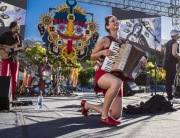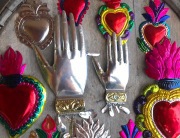Eighteen master artists from 16 countries have been selected by a team of business and folk art experts to be the first to take part in the new International Folk Art Market | Online program. Here are the stories of five of them, each of them remarkable, each of them available for interviews.
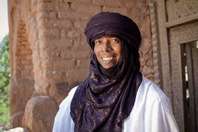 Elhadji Mohamed Koumama of Tuareg Jewelers, Agadez, Niger
Elhadji Mohamed Koumama of Tuareg Jewelers, Agadez, Niger
“Jewelry has always been a part of my life,” explains Elhadji Mohamed Koumama. For 25 generations, Elhadji’s family has been creating handmade silver jewelry and traditional leather bags in and around Agadez, Niger.
Elhadji was born nomadic, and lived as a nomad until he was ten. He was the first in his family to attend school. He has 13 brothers and sisters, and a very large extended family—all of them artists. “You are born into this job,” he says. “You work your way up as an apprentice.” Traditionally, males work with silver, and women with leather.
“The artists,” Elhadji says, “are inspired by the traditional techniques and motifs that are a part of our cultural tradition.” Designs include triangles, which signify luck, and circles, which signify the sun. The cross of Agadez is not only the symbol of the town, but also the symbol of love—such a cross can be found in many of Elhadji’s pieces.
Today, Elhadji’s company, Tuareg Jewelry, employs 35 silversmiths and hosts several apprentices. Many more people in the community contribute leather cord, as well as polishing and beading services. All in all, Elhadji estimates that Tuareg supports over 200 people in the community. He hopes to be able to provide jobs for another 25 artists this year, and to eventually help build a much-needed new school in Agadez.
“Our art is a blessing,” Elhadji says, “for it gives us both income and pride.
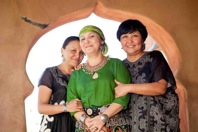 Farzana Sharshemieva and the Seven Sisters, Textile Artists from Bishkek, Kyrgyzstan
Farzana Sharshemieva and the Seven Sisters, Textile Artists from Bishkek, Kyrgyzstan
“People who buy our products carry with them a part of our culture and the warmth of our hands, love, and blessings,” says Farzana Sharshembieva, the oldest of seven sisters who create scarves, clothes, carpets, and shawls of silk and felt. For thirteen years, the sisters have worked together, pressing vibrant felt into rippling designs that tell stories of their culture.
“Our love for this work was instilled by our grandmother, a famous skilled worker,” says Farzana. The sisters can remember, as children, watching their grandmother lay patterns down on the carpet, and listening as she explained the legends associated with each design.
“In Kyrgyz ornaments,” Farzana explains, “you can see the distinct history and lifestyles of the ancient nomads in hunting scenes. Our products depict flora and fauna in signs and symbols that have sacred meanings.” The sisters’ parents were also their teachers. Their father was a master saddle-maker, and their mother embroidered. Both taught at art colleges. “They devoted their lives to creativity,” Farzana says. “Our dad is our main teacher and critic.” His ancestors were also artists—jewelers, blacksmiths, and furriers; the sisters are the sixth generation of artisans in the family.
“We create beautiful things for a living,” explains Farzana. Their art provides them opportunities to exhibit in different countries and to explore and incorporate the beauty and complexity of other cultures into their work. Still, what they love most happens at home: spreading pieces of felt and silk on the floor, and imagining the designs to come and the ancient stories to be told.
 Lila Handicrafts, Textile Artists from, Sindh, Pakistan
Lila Handicrafts, Textile Artists from, Sindh, Pakistan
“Our quilts are handmade from the heart,” says Naina Valasai, a member of Lila Handicrafts, a women’s cooperative based in Sindh, Pakistan. For 10 years, the group has produced ralli quilts and other textiles embroidered in the Sindhi tradition. Today more than 200 artists participate.
“Designs for Rallis have been handed down from our mothers for as long as we can remember,” Naina says. It is estimated that rallis have been prized in Pakistan for thousands of years, serving traditionally as dowry items.
The cooperative has made a big difference for participants’ families, as well as for the broader community. “Women who might otherwise complete only unpaid work at home, are now able to contribute to their families’ incomes,” Naina explains. “We can afford to send our children to school, and we can buy the food ourselves.”
Cotton is used to make the Ralli quilts, and silk thread for the embroidery. It might take as many as three months to complete a single quilt, which showcases dozens of brilliant, finely-cut patches stitched onto a traditionally white background. Most designs are inspired by flowers, but some address everyday objects such as milk churns or palm leaves. The colors of the rally quilts are based on the seven colors of the satrangi color scheme: red, yellow, white, black, green, blue, and purple. “We like the bright colors,” Naina says.
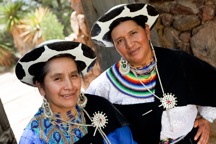 La Mega Cooperative Artesanal de los Saraguros, Jewelers from Saraguros, Ecuador
La Mega Cooperative Artesanal de los Saraguros, Jewelers from Saraguros, Ecuador
“Bead-weaving is satisfying and beautiful, and we know our art will help our children,” says La Mega president Patricia Parra. Since 2010, La Mega Cooperative Artesanal de los Saraguros has produced Czech glass bead-weavings in the form of earrings, necklaces, and bracelets. All 80 artists—mostly women— were born in Los Saraguros, and the cooperative was formed out of five separate women’s organizations, which joined together to internationally market their beadwork.
“The income is very important, of course,” says Patricia, “but the pride in having our beadwork appreciated abroad is critical, too. People in Los Saraguros and around the world look up to us as artists.” Sales benefit the community in a number of ways, covering educational and medical supplies, sewing machines, community buildings, and funds for the local women’s shelter, which is one of the five organizations that comprise La Mega. “Our work has funded many university educations,” Patricia explains.
Czech glass beads were introduced to Ecuador in the 1800’s from Brazil, via the Amazon River. Women complete most of the beadwork in Los Saraguros—girls begin to learn the trade as early as age five. Not all women sell their work, but most mothers, aunts, and sisters teach young women the traditional patterns and techniques.
For the bead-weavers of Los Saraguros, a favorite pattern is matizado, a color-blending weave that resembles a rainbow. The blended shades represent the way that work, family, and religion mix to create a balanced life. For the weavers, the rainbow is sacred; matizado is a prominent element of the traditional wedding necklace.
 Hilda Valeriana Cachi Yupanqui of Joyas Cachi, Jewelers from Cusco, Peru
Hilda Valeriana Cachi Yupanqui of Joyas Cachi, Jewelers from Cusco, Peru
“My art inspires me to keep the tradition of my ancestors alive,” says Hilda Valeriana Cachi Yupanqui. For 44 years, she and her family have designed and created jewelry inspired by the cultures embedded in her native Peru. She describes her work with stone, metal, and glass as a melding of styles: Incan mystic, Spanish Baroque, and international modern.
Her business, Joyas Cachi, has stores in Lima and Cusco, and employs 22 artisans in its workshop. Sales of her jewelry provide her family members and employees with job security, but her work represents much more than income: she is committed to educating her community not only in jewelry-making, but also in its deeply-rooted histories and complex aesthetics.
From designing a piece to shaping and molding silver and clay, from planing a stone to polishing the finished jewel, Hilda is devoted to the fusion of tradition and modernity. She is one of seven sisters, all of whom inherited a love of art from their father. “Now 81, he continues to inspire us to keep creating,” she says. “I was born with art.” Hilda feels fortunate to be selected to participate in IFAM | Online, and she appreciates that the training is delivered through a practical model, one that “allows me to grow as a craftsman and open new business opportunities while helping to make my culture known throughout the world.”
For more information, interview requests, and photos, please contact Clare Hertel at 505-474-6783 or clare@clarehertelcommunications.com.


